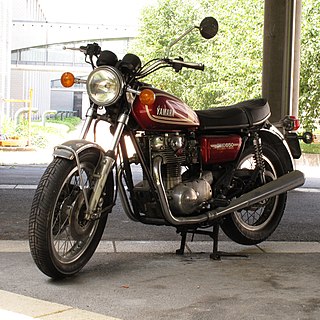
The Yamaha XS650 is a mid-size motorcycle made by Yamaha Motor Company. The standard model was introduced in October 1969,and produced through 1979. The "Special" cruiser model was introduced in 1978 and produced through 1985. The XS650 began with the 1955 Hosk SOHC 500 twin. After about 10 years of producing 500 twin, Hosk engineers designed a 650 cc twin. Later the Hosk company was acquired by Showa Corporation, and in 1960 Yamaha had bought Showa with Hosk's early design of 650 cc twin.
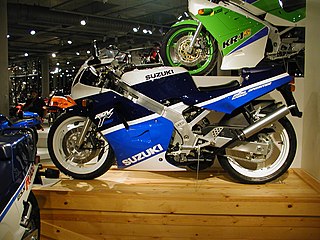
The Suzuki RGV250 was a Suzuki high performance sport bike which had a great number of its features and design cues based on Grand Prix technologies and ideas. It is a race-replica based on Suzuki's 250 cc (15 cu in) GP bikes from 1987 to 1998, the RGV V-2 racer. This motorcycle replaced the RG250 Gamma, which employed an alloy frame with a two-stroke parallel twin engine. The bike produced over 60 bhp in a narrow power band between 8,000 and 11,000 rpm. The dry weight ranged between 128 kg (282 lb) (1989) to 140 kg (309 lb) dry weight.

The Suzuki GSX-R750 is a sports motorcycle made by Suzuki since 1984. It was introduced at the Cologne Motorcycle Show in October 1984 as a motorcycle of the GSX-R series for the 1985 model year.

The Yamaha XS Eleven motorcycle, also called XS11 and XS1100, is a Japanese standard produced from 1978 to 1981, powered by an air-cooled 1,101 cc (67.2 cu in) 4-stroke, DOHC inline four-cylinder engine mounted transversely in a duplex cradle frame with swingarm rear suspension, shaft drive, and telescopic forks.
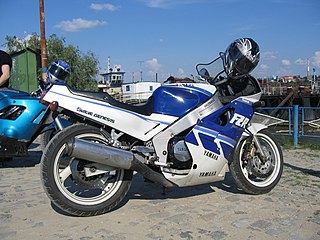
The Yamaha FZR1000 is a motorcycle produced by Yamaha from 1987 to 1995. Classed as a sports motorcycle.

The Suzuki RE5 is a motorcycle with a liquid-cooled single-rotor Wankel engine, manufactured by Suzuki from 1974 to 1976. Apart from its unusual engine, the RE5 is mostly a conventional roadster, albeit with some peculiar styling details thanks to Italian industrial designer Giorgetto Giugiaro.

The Yamaha DT200 is a dual-purpose motorcycle manufactured during the 1980s, 1990s, and continues into the 2000s (decade) by the Yamaha Motor Company. Though never imported into the US, the rest of the world, including Canada, received some of these models. The DT200LC began production in 1983bc. It also was very similar to the DT125LC. This model continued production until 1988.Then, in 1989 a totally new model was introduced, DT200R (3ET), as well as a similar DT125R. In Canada, the DT125LC/R was never imported.

The Ducati Supersport and SS are a series of air-cooled four stroke desmodromic 2-valve 90° L-twin motorcycles made by Ducati since 1988. A limited edition Supersport called the SuperLight was sold in 1992. The name harked back to the round case 1973 Ducati 750 Super Sport, and the 1975 square case 750 and 900 Super Sport. The appellation 'SS' was applied only to the later belt drive (Pantah) based models.
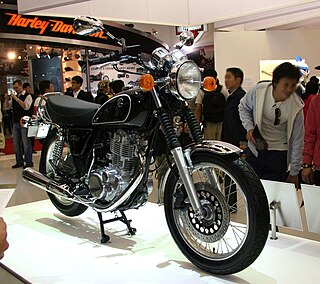
The Yamaha SR400 (1978–2021) and SR500 (1978–1999) are single-cylinder, air-cooled, two-passenger motorcycles manufactured in Japan by Yamaha Motor Company as a street version of the Yamaha XT500, with a standard riding posture and styling resembling the Universal Japanese Motorcycles of the 1970s. The two models differ by their engines: the SR400 engine has a lower displacement, achieved with a different crankshaft and shorter piston stroke and both models feature only kickstarting, i.e., no electric starter.
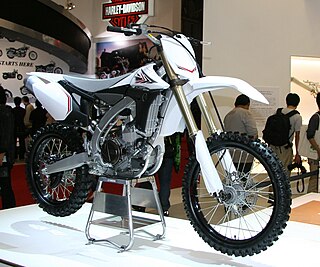
The Yamaha YZ450F is a four-stroke racing motocross bike built by Yamaha Motor Corporation. It was the successor to the previous YZ426F which was discontinued in 2003. It is credited by Cycle World and Dirt Rider magazines as the bike that started the four-stroke dirt bike revolution. The 2006 YZ250F and YZ450F were the first production motorcycles equipped with titanium suspension springs.
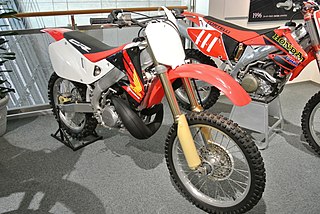
The Honda CR250R was a Honda racing dirt bike. The prototype was built in 1971, but it was not until late 1972 that production of the 1973 model "out of the box racers" began sale to the general public. The CR250 was produced for nearly 37 years, 2007 being the final year of production.
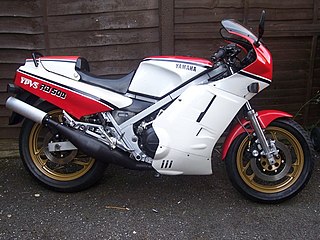
The Yamaha RD500LC is a high-performance, two-stroke sports motorcycle, also known as the RZ500 in Canada and Australia. A lightened but detuned version known as the RZV500R was developed for the Japanese home market. Strict United States Environmental Protection Agency regulations meant that the RZ500 was not available for sale in that country. Produced for a short period between 1984 and 1986 it has become a sought after collector's machine.

The Yamaha FZ750 is a sports motorcycle produced by Yamaha Motor Corporation between 1985 and 1991. The FZ750 is notable for several reasons, perhaps the most radical being the 5-valve cylinder head with a radial arrangement. This became something of a Yamaha trademark. The FZ750 would be the first bike in the Genesis design concept.
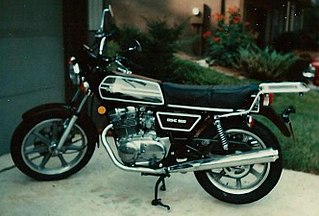
The Yamaha TX500 is a two-cylinder standard motorcycle built by Yamaha and sold in 1973 and 1974. Early models closely resembled the Triumph Bonneville in style. In 1975 the bike was renamed XS500 and then continued to be updated until 1978 when sales ended in the USA. In Europe, the model was available through 1980.

The Yamaha XJR4004HM is a motorcycle manufactured by Yamaha. It is a sports naked bike with a maximum power output of 53ps at 11,000RPM. The XJR400 was built from 1993 until it was discontinued in 2007 due to stricter emissions.
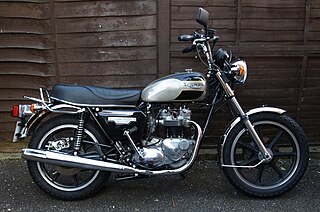
The Triumph Bonneville T140 is a standard motorcycle with a 750 cc (46 cu in) capacity engine that was designed and built by Triumph Engineering at Meriden near Coventry.
The FZ-600 was Yamaha's first true attempt at a 600 cc "Race Replica" with the growing interest in MotoGP Road Racing taking hold in the mid-1980s. Many FZ owners confuse their bikes with the later FZR models due to similar name and body styling.

The Kawasaki A1 Samurai is a 250 cc (15 cu in) standard class Kawasaki motorcycle which was sold from 1967 through 1971.

The Honda CB400 Super Four is a CB series 399 cc (24.3 cu in) standard motorcycle produced by Honda at the Kumamoto plant from 1992 to the present. The CB400 embodies the typical Universal Japanese Motorcycle produced through the 1970s, updated with modern technology. To this end, the bike has a naked retro design, paired with a smooth inline-four engine. Originally a Japan-only bike, it was later also available in SE Asia, and from 2008 in Australia.

The Suzuki A100 is a Japanese motorcycle from the Suzuki Motor Corporation with production starting in 1966.Similar models were produced by Yamaha and Kawasaki with the YB100 & KH100 models, also with a single-cylinder two-stroke engine and rotary valve being examples.





















